Related Research Articles

The City of Cripple Creek is the Statutory City that is the county seat of Teller County, Colorado, United States. Cripple Creek is a part of the Colorado Springs, CO Metropolitan Statistical Area. The city population was 1,189 at the 2010 United States Census. Cripple Creek is a former gold mining camp located 44 miles (71 km) southwest of Colorado Springs near the base of Pikes Peak. The Cripple Creek Historic District, which received National Historic Landmark status in 1961, includes part or all of the city and the surrounding area. The city is now a part of the Colorado Springs, CO Metropolitan Statistical Area.
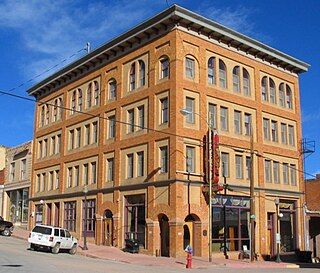
The City of Victor is a Statutory City in Teller County, Colorado, United States. Gold was discovered in Victor in the late 19th century, an omen of the future of the town. With Cripple Creek, the mining district became the second largest gold mining district in the country and realized approximately $10 billion of mined gold in 2010 dollars. It reached its peak around the turn of the century when there were about 18,000 residents in the town. Depleted ore in mines, labor strife and the exodus of miners during World War I caused a steep decline in the city's economy, from which it has never recovered. The population was 397 at the 2010 census. There is a resumed mining effort on Battle Mountain.
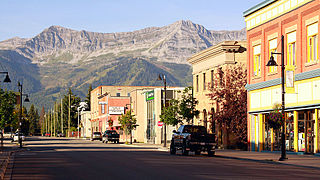
Fernie is a city in the Elk Valley area of the East Kootenay region of southeastern British Columbia, Canada, located on BC Highway 3 on the eastern approaches to the Crowsnest Pass through the Rocky Mountains. Founded in 1898 and incorporated as the City of Fernie in July 1904, the municipality has a population of over 5,000 with an additional 2,000 outside city limits in communities under the jurisdiction of the Regional District of East Kootenay. A substantial seasonal population swells the city during the winter months.
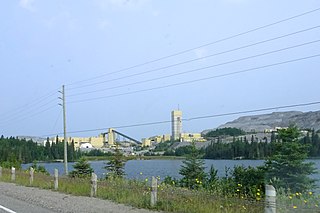
Barrick Gold Corporation is a mining company that produces gold and copper with 16 operating sites in 13 countries. It is headquartered in Toronto, Ontario, Canada. It has mining operations in Argentina, Canada, Chile, Côte d'Ivoire, Democratic Republic of the Congo, Dominican Republic, Mali, Papua New Guinea, Saudi Arabia, Tanzania, the United States and Zambia. In 2019, it produced 5.5 million ounces of gold at all-in sustaining costs of $894/ounce and 432 million pounds of copper at all-in sustaining costs of $2.52/pound. As of December 31, 2019, the company had 71 million ounces of proven and probable gold reserves.
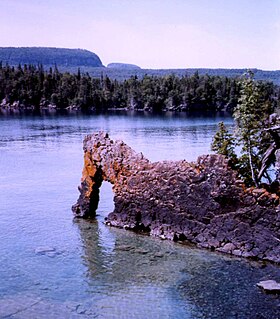
Unorganized Thunder Bay District is an unorganized area in northwestern Ontario, Canada in Thunder Bay District. It comprises all parts of the district that are not part of an incorporated municipality or a First Nations reserve.
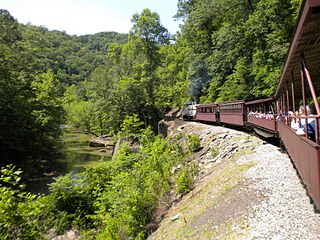
The Big South Fork Scenic Railway is a heritage railroad in Stearns, Kentucky.

A1 Mine Settlement is a town in Victoria, Australia, located north of Woods Point on the Mansfield - Woods Point Road, in the Shire of Mansfield. The town has also been known as Castle Reef, Castle Point, and Raspberry Creek.

Greenwood is a city in south central British Columbia. It was incorporated in 1897 and was formerly one of the principal cities of the Boundary Country smelting and mining district. It was incorporated as a city originally and has retained that title despite the population decline following the closure of the area's industries.

Tilt Cove is a town located southeast of Baie Verte on Notre Dame Bay and was founded in 1813. With an official population of 5 at the 2016 census, Tilt Cove is known as "Canada's smallest town." A source of gold, copper, and zinc ores, Tilt Cove was the site of the first mine in Newfoundland. The Tilt Cove mine opened in 1864 and "was soon employing several hundred men at good wages". Postal service was established in 1869.

The Cassiar Country, also referred to simply as the Cassiar, is a historical geographic region of the Canadian province of British Columbia. The Cassiar is located in the northwest portion of British Columbia, just to the northeast of the Stikine Country, while to the south is the Omineca Country. The area is noted for the Cassiar gold rush of the 1870s, when Laketon became its unofficial capital. The ghost town of Cassiar is also located in the Cassiar region.

Centerra Gold Inc. is a Canadian mining company that owns and operates the Kumtor Gold Mine in the Kyrgyz Republic, the Mount Milligan copper-gold mine in British Columbia, Canada, and the Öksüt gold mine in Turkey. Through its Thompson Creek Metals subsidiary company, it also own the Endako and Thompson Creek molybdenum mines in British Columbia and Idaho, respectively, though they have been inactive since Centerra's acquisition. The company formerly owned and operated the Boroo Gold Mine in Mongolia. Headquartered in Toronto, Centerra Gold is a public company with shares traded on the Toronto Stock Exchange and New York Stock Exchange.

Heron Park is a neighbourhood in Capital Ward in Ottawa, Ontario, Canada. Its boundaries are the Rideau River to the north, the Sawmill Creek to the west, Bank Street to the east, Walkley Road to the south.
Mauritania's mineral sector was dominated by iron ore mining and beneficiation. Other mineral commodities produced in the country included cement, copper, gold, gypsum, petroleum, salt, and steel. The Ministère des Mines et de l’Industrie was the Government agency responsible for enacting the Mining Code and for the coordination of all activities in the mining sector. The Direction des Mines et de la Géologie was the entity responsible for promoting the mineral sector and for providing geologic and mining information to potential investors; the Direction des Hydrocarbures was in charge of the development of the petroleum sector; and the Office Mauritanien des Recherches Géologiques was the Government entity responsible for evaluating areas of mineral potential for exploration. Société Nationale Industrielle et Minière (SNIM) was responsible for iron ore production and benefciation.

Thompson Creek Metals Company Inc. was a full cycle mining company with acquisition, exploration, development, and operation in North America. The corporate office was located in Denver, Colorado. The company primarily produced copper, gold, and molybdenum. Over its history, the Company evolved from being a major primary molybdenum producer to becoming a copper and gold mining company with the construction and development of the Mount Milligan mine and concentrator in British Columbia, Canada. Mount Milligan was Thompson Creek Metals principal operation and the company owned 100% of this property. The company also owned 100% of its Thompson Creek Mine in Idaho. Thompson Creek Metals owned 75% joint venture interest in two other properties, including its Endako Mine in British Columbia, and its Langeloth Metallurgical Facility (roaster) in Pennsylvania. Thompson Creek Metals had additional development projects, including the Berg property in British Columbia.

Gold Rush is a reality television series that airs on Discovery and its affiliates worldwide. The series follows the placer gold mining efforts of various family-run mining companies, mostly in the Klondike region of Dawson City, Yukon, Canada. In its 11th season as of early 2020, prior seasons also included mining efforts in South America and western North America.

Dunn Peak is a group of peaks in the central Interior of British Columbia, Canada. Its most prominent summit, Matterhorn Peak, rises to 2,636 metres (8,648 ft), making it the highest point in the Shuswap Highland.

Tahoe Resources Inc. was a mining company and intermediate precious metals producer with silver and gold mines in Canada, Guatemala and Peru. It was founded in Vancouver, British Columbia by Kevin McArthur, former CEO of Glamis Gold and Goldcorp. Incorporated in British Columbia, Canada, the company's U.S. headquarters is located in Reno, Nevada.
The Cripple Creek Gold Rush was a period of gold production in the Cripple Creek area from the late 1800s until the early 1900s. Mining exchanges were in Cripple Creek, Colorado Springs, Pueblo and Victor. Smelting was in Gillett, Florence, and (Old) Colorado City. Mining communities sprang up quickly, but most lasted only as long as gold continued to be produced. Settlements included:

The Mount Polley mine is a Canadian gold and copper mine located in British Columbia near the towns of Williams Lake, and Likely. It consists of two open-pit sites with an underground mining component and is owned and operated by the Mount Polley Mining Corporation, a wholly owned subsidiary of Imperial Metals Corporation. In 2013, the mine produced an output of 38,501,165 pounds (17,463,835 kg) of copper, 45,823 ounces of gold, and 123,999 of silver. The mill commenced operations in 1997 and was closed and placed on care and maintenance in 2019. The company owns 20,113 hectares (201.13 km2) of property near Quesnel Lake and Polley Lake where it has mining leases and operations on 2,007 hectares (20.07 km2) and mineral claims on 18,106 hectares (181.06 km2). Mineral concentrate is delivered by truck to the Port of Vancouver.
References
- ↑ N.L. Barlee (1980), The Guide to Gold Panning, Revised Second Edition, Second Printing. Canada West Publications., ISBN 0-920164-04-8